Table of Contents
- Introduction to Preventive Healthcare
- Editor’s Choice
- What is Preventive Healthcare?
- Preventive Healthcare Measures Statistics
- Hospital Visits by Patients’ Age and Gender
- Leading Causes of Preventable Death Worldwide
- Preventive Interventions for Child Mortality
- Preventive Healthcare Statistics by Country
- Recent Developments
- Key Takeaways
- FAQs
Introduction to Preventive Healthcare
Preventive Healthcare Statistics: Preventive healthcare plays a crucial role in promoting overall well-being and reducing the burden of diseases. It focuses on proactive measures such as vaccinations, screening, early detection, and lifestyle modifications to prevent various health conditions.
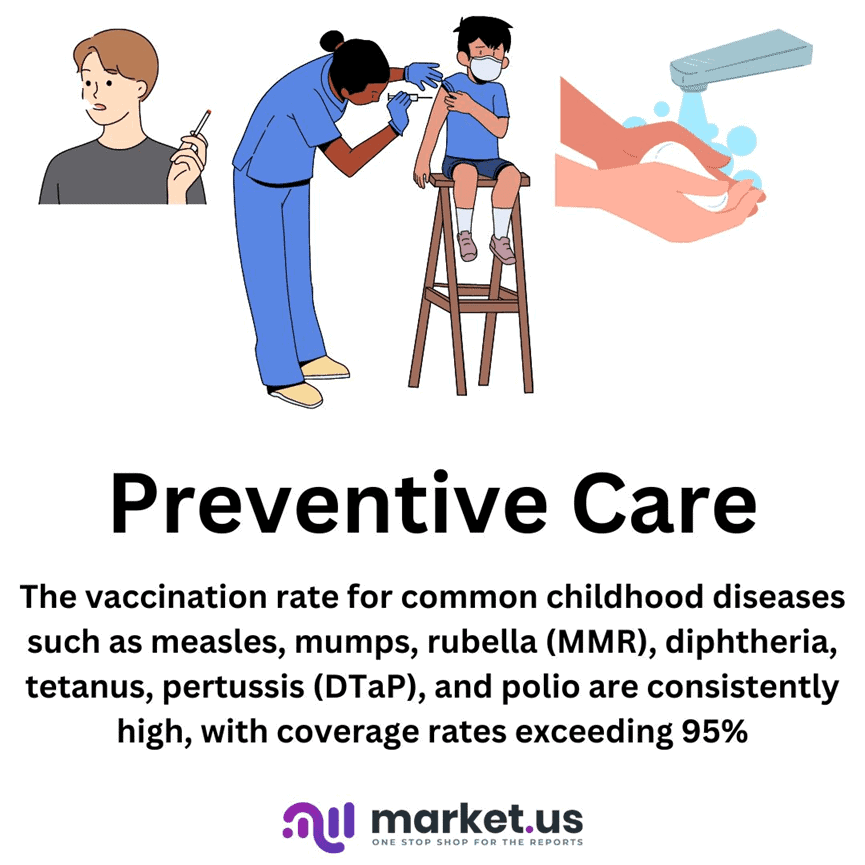
Editor’s Choice
- Noncommunicable diseases (NCSs) such as cardiovascular diseases, cancer, chronic respiratory diseases, and diabetes account for approximately 71% of all global deaths.
- Preventive healthcare services can reduce premature deaths by about 40%.
- The CDC estimates that for every dollar spent on preventive services, the healthcare systems save between USD 2 and USD 10 in future costs.
- The influenza vaccination coverage among adults in the United States in 2019-2020 was around 48%.
- The global preventive healthcare market is projected to reach USD 345 billion by 2029 at a CAGR of 9.6%.
- 90% of the nation’s $4.1 trillion in annual healthcare expenditures are for people with chronic and mental health conditions.
- More than 877,500 Americans die of heart disease or stroke every year.
(Source: WHO, CDC, ihealthcareanalyst)
What is Preventive Healthcare?
Preventive healthcare also known as preventive medicine or preventive care, refers to the measures taken to prevent diseases, injuries, or other health conditions before they occur or progress.
Preventive healthcare includes various aspects such as regular screening, vaccinations, lifestyle modifications, and education on healthy behaviors.
Prevalence of Preventable CVDs
- Cardiovascular diseases are the leading cause of death worldwide.
- About 19% of people died from CVDs in 2019, which represents 32% of all global deaths. Out of these deaths, 85% were due to heart attack and stroke.
- About 80% of premature heart diseases and strokes can be prevented through lifestyle modifications such as a healthy diet, regular physical activity, and avoiding tobacco use.
- In the United States, cardiovascular diseases are responsible for approximately 1 in 4 deaths.
- 1 person dies every 33 seconds in the United States from cardiovascular diseases.
- About 695,000 people in the United States died from heart disease in 2021.
- Blood pressure control reduces the risks of cardiovascular diseases by 70%.
- Tobacco avoidance, a healthy diet, and regular exercise reduce the risk of cardiovascular diseases by 80%, 65%, and 75% respectively.
(Source: CDC, WHO, American Heart Association)
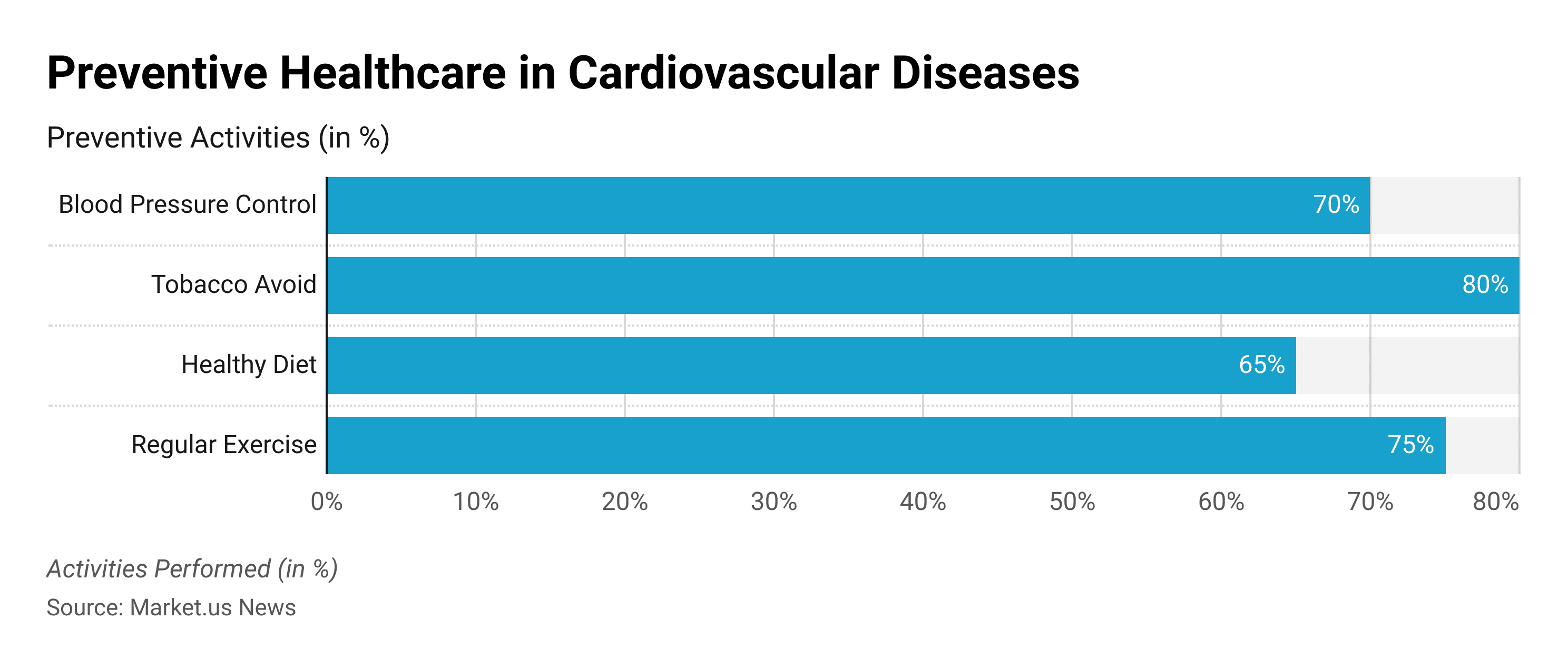
Preventive Healthcare Statistics – Prevalence and Prevention of Cancer
- According to WHO, 30-35% of cancer cases are preventable by avoiding risk factors such as tobacco use, unhealthy diets, physical inactivity, and harmful alcohol consumption.
- Tobacco use is the single largest preventable cause of cancer worldwide, accounting for approximately 22% of cancer-related deaths.
- There were about 18 million new cancer cases worldwide in 2020.
- More than 4 in 10 new cases of cancer are lung, female breast, bowel, or prostate cancer, 2020, worldwide.
- Tobacco control reduces the risks of cancer by 60%.
- A healthy diet, physical activity, and regular screening reduce the risks of cancer by 70%, 45%, and 89% respectively.
(Source: WHO, Cancer Research UK)
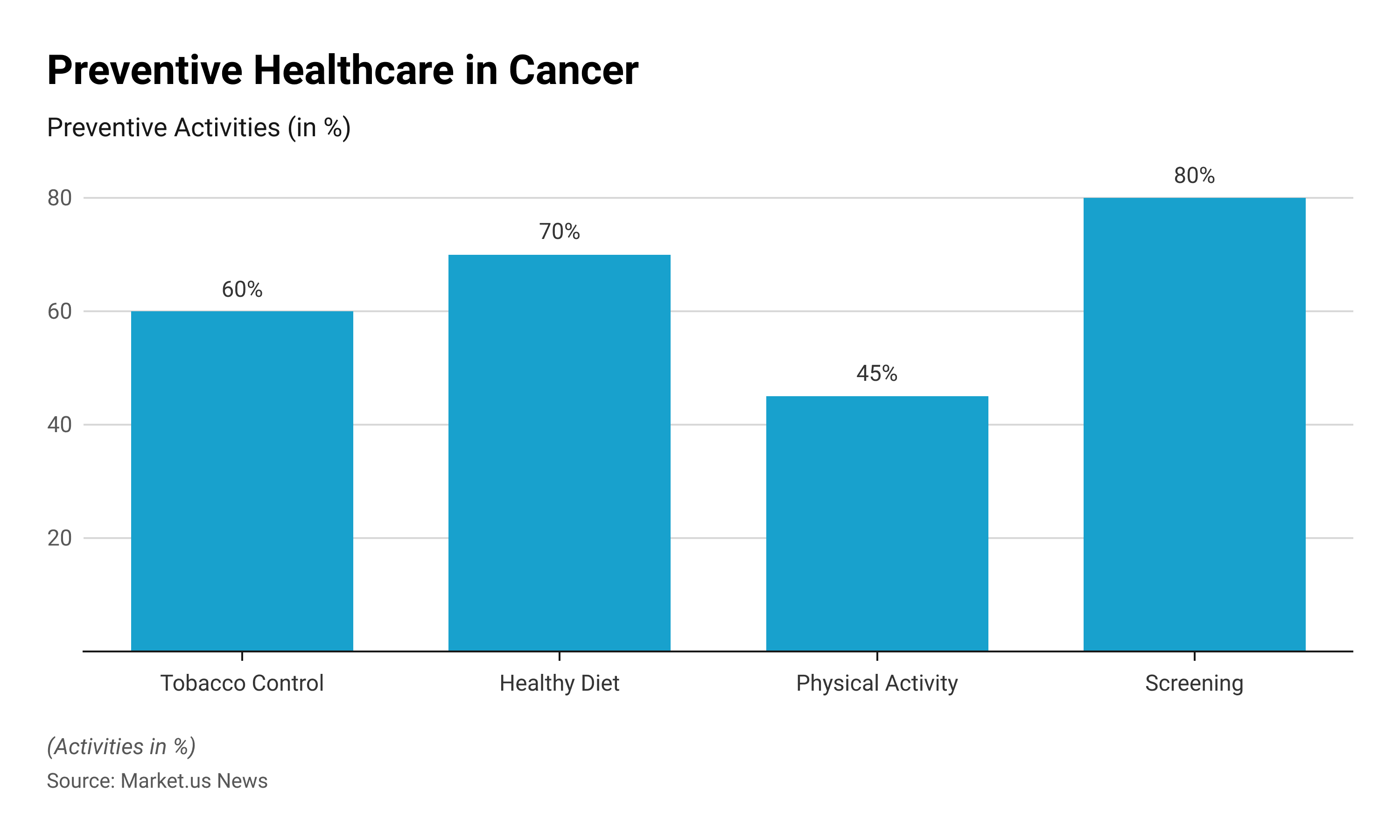
Prevalence and Prevention of Diabetes – Preventive Healthcare Statistics
- In 2021, about 537 million adults worldwide had diabetes, and the number is projected to reach 642 million by 2040.
- Type 2 diabetes, which accounts for the majority of diabetes cases, is largely preventable through regular physical activity, a healthy diet, weight management, and avoiding tobacco use.
- The global prevalence of T2DM in adults was about 536.6 million people in 2021. This number is expected to reach 783.2 million people in 2045.
- Between 2000 and 2019, there was a 3% increase in diabetes mortality rate by age.
- About 8.4 million people are living with Type 1 diabetes across the globe.
(Source: International Diabetes Federation, BioMed Central, WHO)
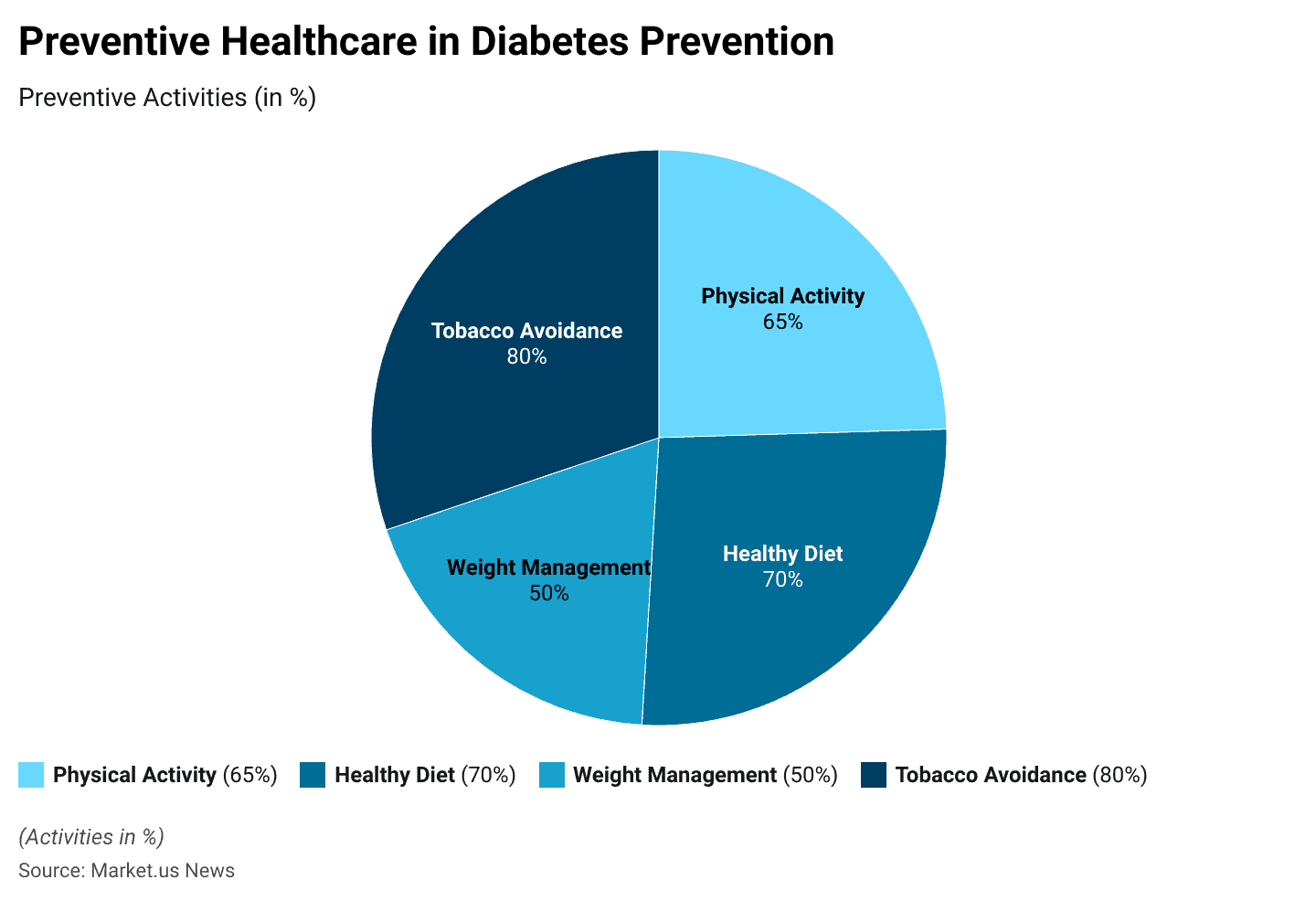
Prevalence and Prevention of Respiratory Diseases – Preventive Healthcare Statistics
- Tobacco smoking is a major risk factor for respiratory diseases. Smoking causes about 7 million deaths per year, with around 1.2 million of these deaths attributed to smoke exposure.
- About 91% of the world’s population lives in places where air quality exceeds the recommended limit.
- Respiratory diseases are responsible for a significant global burden of diseases. In 2019, about 9% of the global population suffered from chronic respiratory diseases.
- Respiratory diseases affect over 200 million people and are responsible for 3 million deaths each year.
- Globally, about 262 million people had asthma in 2019, and it is responsible for 461,000 deaths annually.
(Source: WHO)
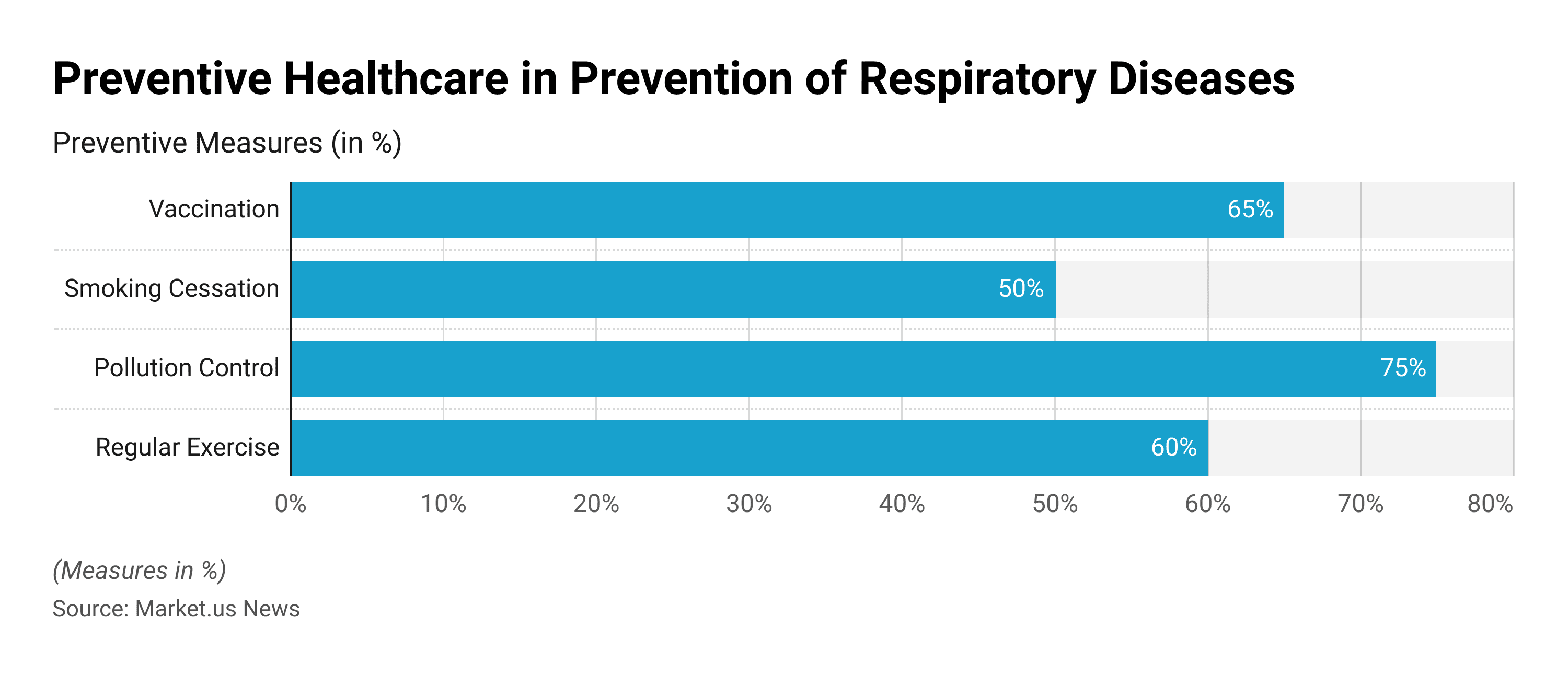
Preventive Healthcare Measures Statistics
Vaccination
Vaccination is a crucial preventive measure in healthcare that helps protect individuals and communities from various infectious diseases.
- The vaccination for adults aged 19 to 35 months varies by vaccine, with the rate generally high for recommended vaccines like measles, mumps, rubella (MMR) (Over 90%), polio (Over 90%), and varicella (Chickenpox) (Over 90%).
- In the United States, in 2020-2021 the overall flu vaccination coverage for individuals aged 6 months and older was 52.8%.
- About 4 million deaths worldwide are prevented by childhood vaccination every year.
- More than 50 million deaths can be prevented through immunization between 2021 to 2030.
- It is projected that Measles vaccination can save nearly 19 million lives by 2030, and Hepatitis B vaccination can save 14 million lives by 2030.
- The global coverage of vaccines dropped from 86% in 2019 to 81% in 2021.
- In 2021, the number of completely unvaccinated children increased by 5 million since 2019.
(Source: CDC, WHO)
Vaccination Coverage for Different Vaccines
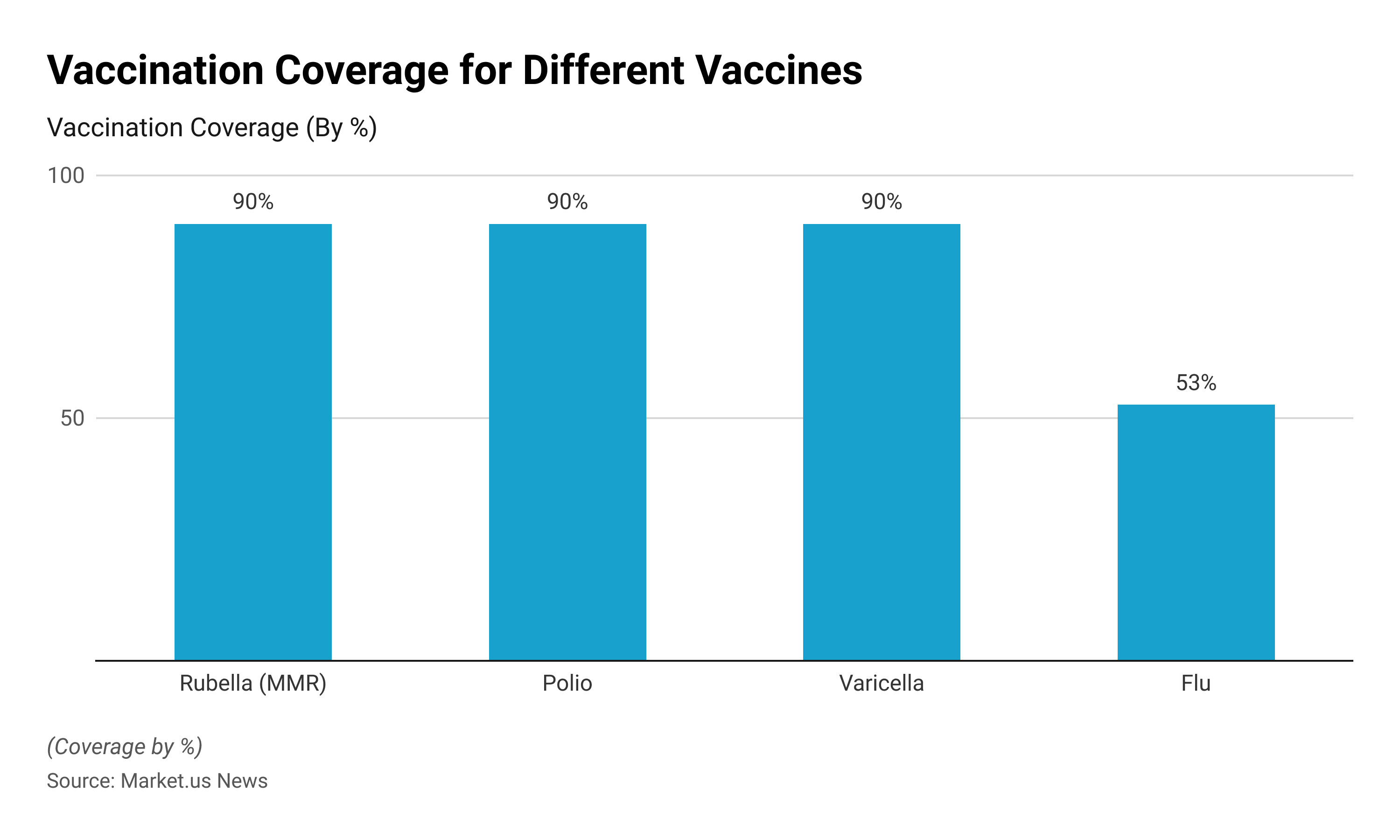
Screening and Early Detection – Preventive Healthcare Statistics
- The mammography screening rates among women aged 40 and more in the United States have been relatively stable, with about 65% to 70% of women in this age group having a mammogram within the past two years.
- In the United States, about 67% of adults aged 50 to 75 years were up-to-date with colorectal cancer screening in 2020.
- According to the National Lung Screening Trial, LDCT screening reduces lung cancer mortality by 20% compared to chest X-ray screening.
- About 6 in 10 adults in 2022 were diagnosed with lung cancer at stage 1, while less than 1 in 10 adults was diagnosed with cancer in stage 4.
- In 2022, 9 in 10 adults were diagnosed with bowel diseases at stage 1, while 1 in 10 adults were diagnosed in stage 4.
- Almost all women are diagnosed with breast cancer at stage one, while around 3 in 10 women are diagnosed with breast cancer at stage 4.
(Source: CDC, Cancer Research UK)
Lifestyle Modifications – Preventive Healthcare Statistics
- Globally, 1 in 4 adults does not meet the minimum physical activity recommendations, which is at least 150 minutes of moderate-intensity aerobic physical activity or 75 minutes of vigorous-intensity aerobic physical exercise per week.
- Only 1 in 10 adults meet the recommended daily intake of fruits and vegetables.
- Behavior could prevent 80% of heart diseases, stroke, Type 2 diabetes, and 40% of cancer diagnoses.
- Lifestyle modifications such as regular physical activity, healthy diet, avoidance of tobacco use, and avoidance of alcohol use reduce the risk of diseases cause by 70%, 60%, 80%, and 75% respectively.
(Source: WHO, UT Southwestern, CDC)
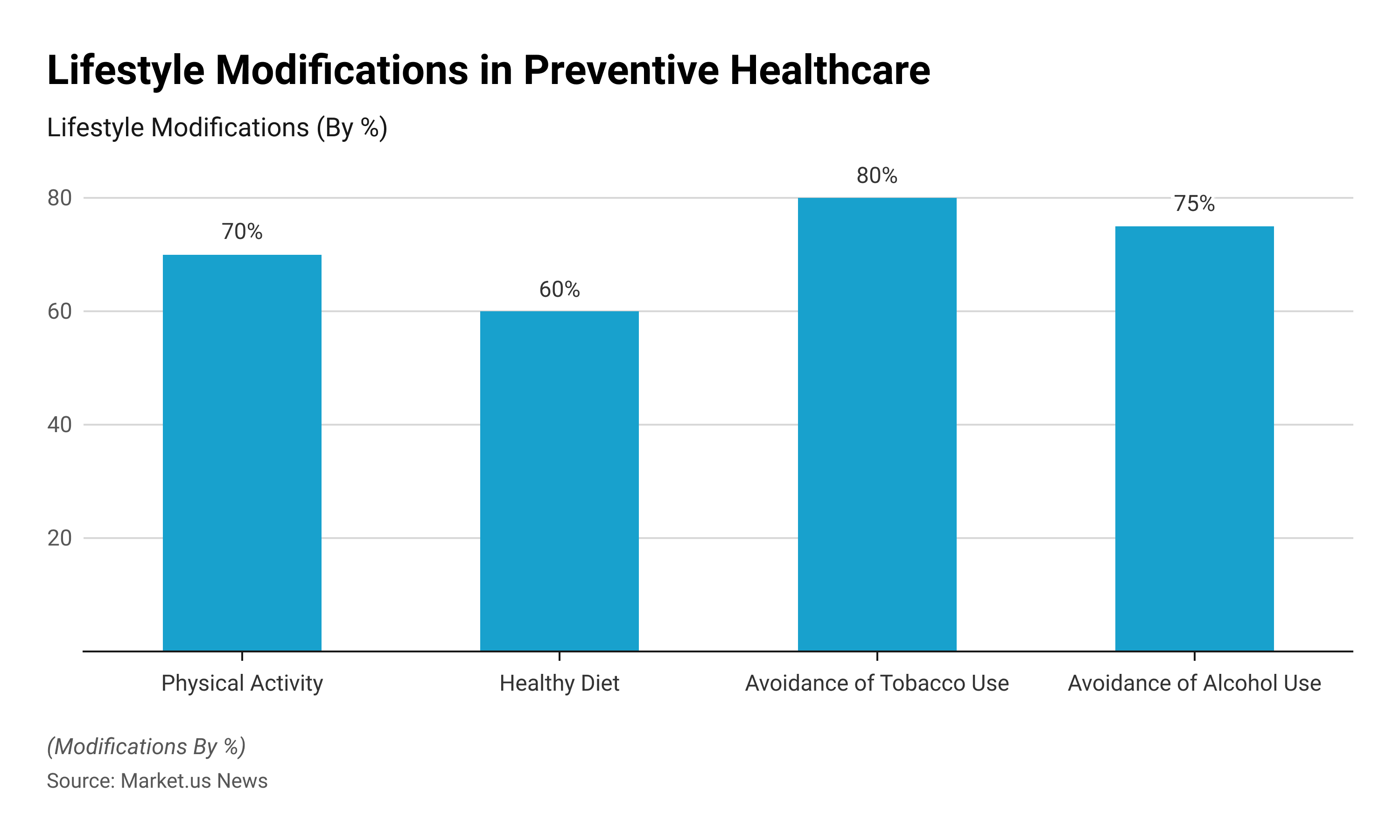
Hospital Visits by Patients’ Age and Gender
- In 2022, there were approximately 61.4 preventive care office visits for every 100 individuals. Out of every 100 females, around 76.6 visited hospitals or healthcare facilities for preventive care, whereas for every 100 males, approximately 45.4 visited preventive care services.
- Children under the age of 18 had a higher rate of preventive care visits, with 73.2 per 100 persons. Similarly, individuals aged 65 years and above also have a higher rate of preventive care visits, with 81.1 visits per 100 persons. On the other hand, adults aged 18-44 have a slightly lower rate of preventive care visits, with 53.2 visits per 100 persons, while those aged 45-64 had a lower rate with 51.8 visits per 100 persons.
- Among women, those aged 18-44 years had a higher rate of preventive care visits, with 87.1 visits per 100 women. In comparison, women aged 45-64 had a lower rate of preventive care visits, with 60.5 visits per 100 women.
- Women aged 18-44 years had a higher rate of preventive care visits with 87.1 visits per 100 women, compared to men in the same age group who had only 18.5 visits per 100 persons. Similarly, women aged 45-64 years also had a higher rate of preventive care visits at 60.5 visits per 100 women.
(Source: CDC)
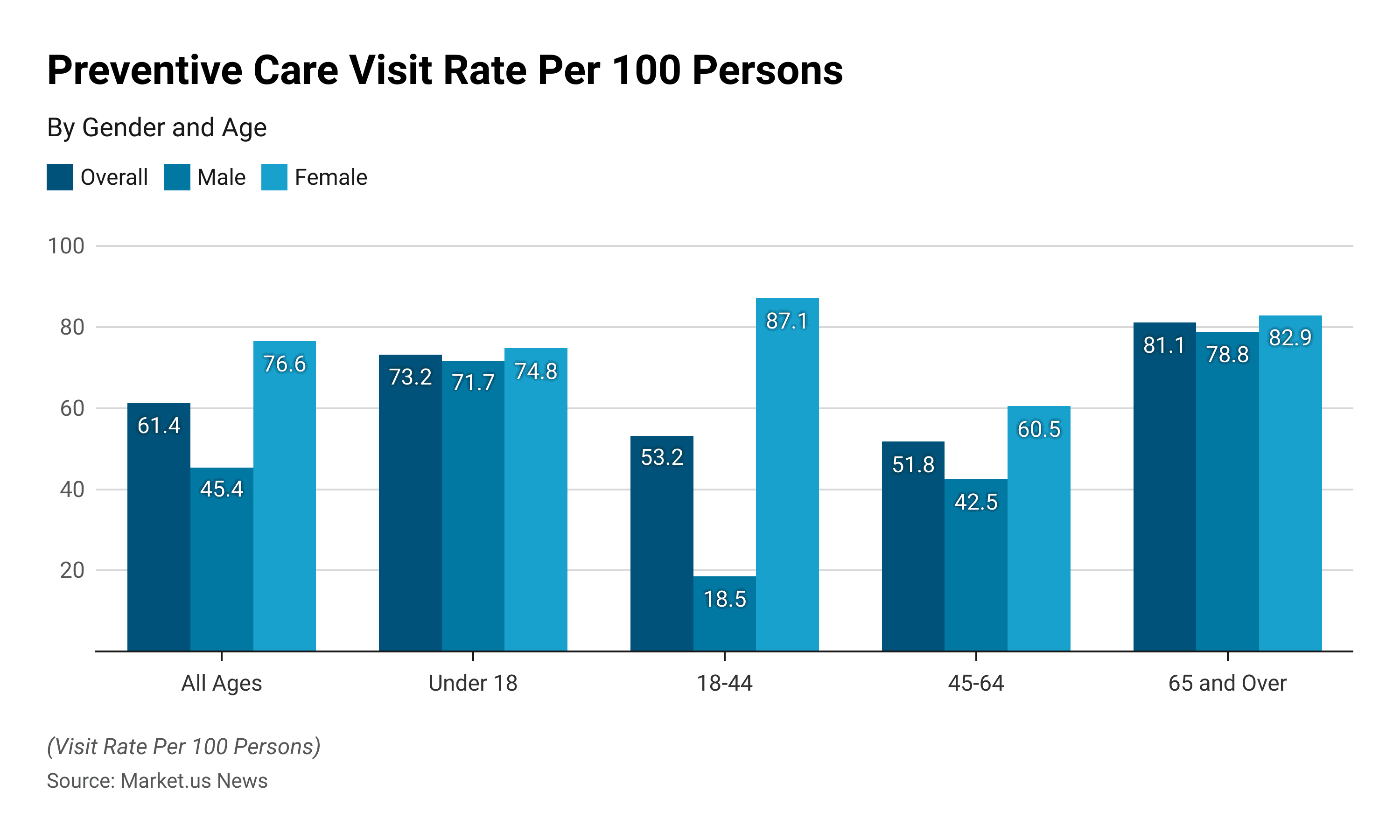
Leading Causes of Preventable Death Worldwide
- Hypertension: Hypertension causes approximately 7.8 million deaths per year.
- Smoking: Smoking is responsible for around 5.0 million deaths annually.
- High cholesterol: Approximately 3.9 million deaths occur each year due to high cholesterol levels.
- Malnutrition: Malnutrition contributes to roughly 3.8 million deaths annually.
- Sexually transmitted infections: Sexually transmitted infections lead to approximately 3.0 million deaths per year.
- Poor diet: Poor diet is responsible for around 2.8 million deaths annually.
- Overweight and obesity: Overweight and obesity contribute to approximately 2.5 million deaths per year.
- Physical inactivity: Physical inactivity leads to around 2.0 million deaths annually.
- Alcohol: Approximately 1.9 million deaths occur each year due to alcohol consumption.
- Indoor air pollution from solid fuels: Indoor air pollution from solid fuels causes around 1.8 million deaths per year.
- Unsafe water and poor sanitation: Roughly 1.6 million deaths occur annually due to unsafe water and poor sanitation.
(Source: CDC, WHO)
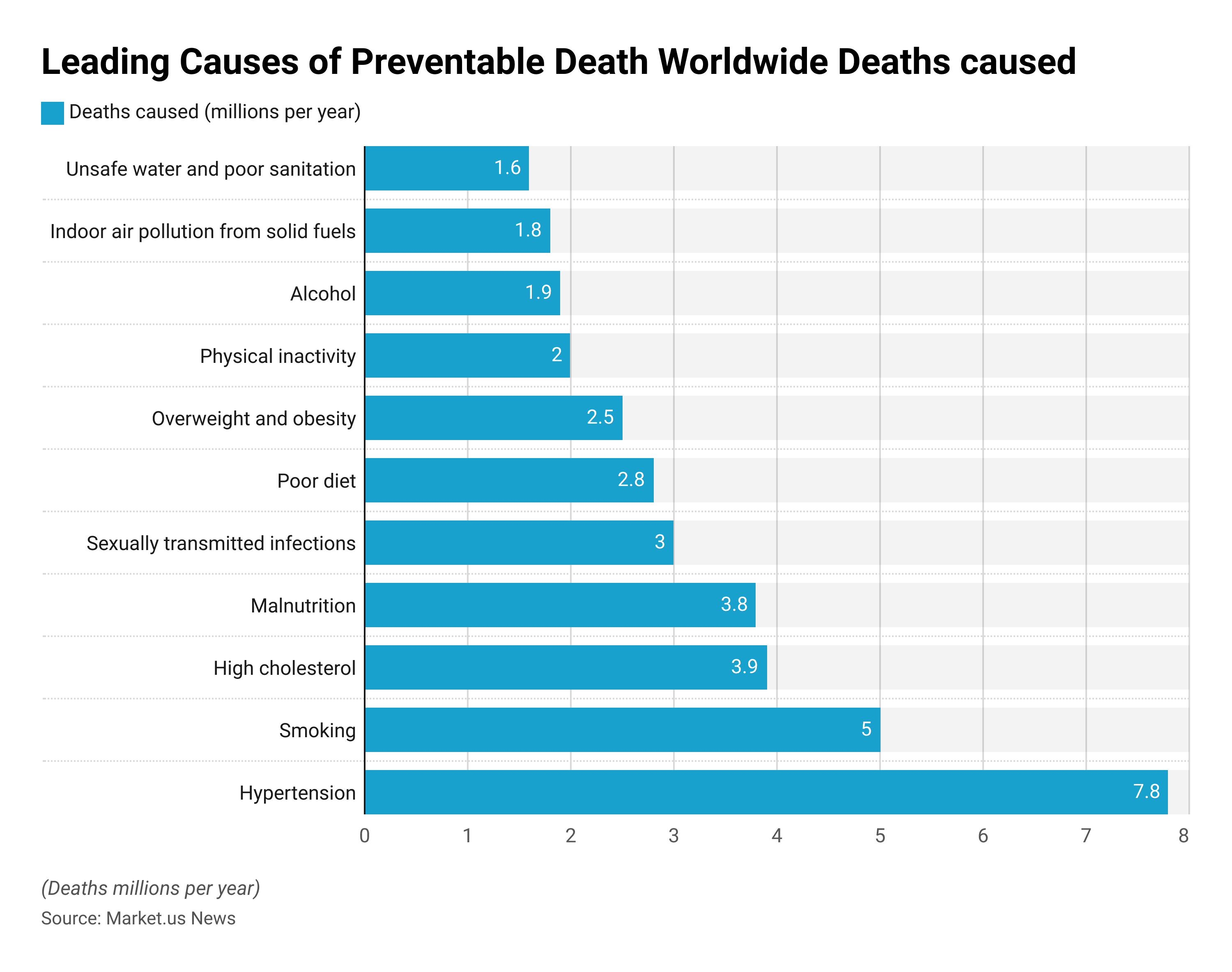
Preventive Interventions for Child Mortality
- Breastfeeding: Approximately 13% of all child deaths could be prevented through breastfeeding.
- Insecticide-treated materials: The use of insecticide-treated materials has the potential to prevent around 7% of child deaths.
- Complementary feeding: Adequate complementary feeding practices can help prevent about 6% of child deaths.
- Zinc: Zinc supplementation can contribute to preventing approximately 4% of child deaths.
- Clean delivery practices: Ensuring clean delivery practices can help prevent around 4% of child deaths.
- Hib vaccine: The Haemophilus influenza type b (Hib) vaccine has the potential to prevent about 4% of child deaths.
- Water, sanitation, hygiene: Improved water, sanitation, and hygiene practices can contribute to preventing approximately 3% of child deaths.
- Antenatal steroids: Antenatal steroid administration can help prevent about 3% of child deaths.
- Newborn temperature management: Appropriate newborn temperature management measures have the potential to prevent around 2% of child deaths.
- Vitamin A supplementation: Vitamin A supplementation can contribute to preventing approximately 2% of child deaths.
- Tetanus toxoid vaccination: The administration of tetanus toxoid vaccine can help prevent about 2% of child deaths.
- Nevirapine and replacement feeding: Using nevirapine and appropriate replacement feeding practices can prevent around 2% of child deaths.
- Antibiotics for premature rupture of membranes: Antibiotic treatment for premature rupture of membranes has the potential to prevent about 1% of child deaths.
- Measles vaccine: The measles vaccine can contribute to preventing approximately 1% of child deaths.
- Antimalarial intermittent preventive treatment in pregnancy: Antimalarial intermittent preventive treatment in pregnancy has a prevention rate of less than 1% for child deaths.
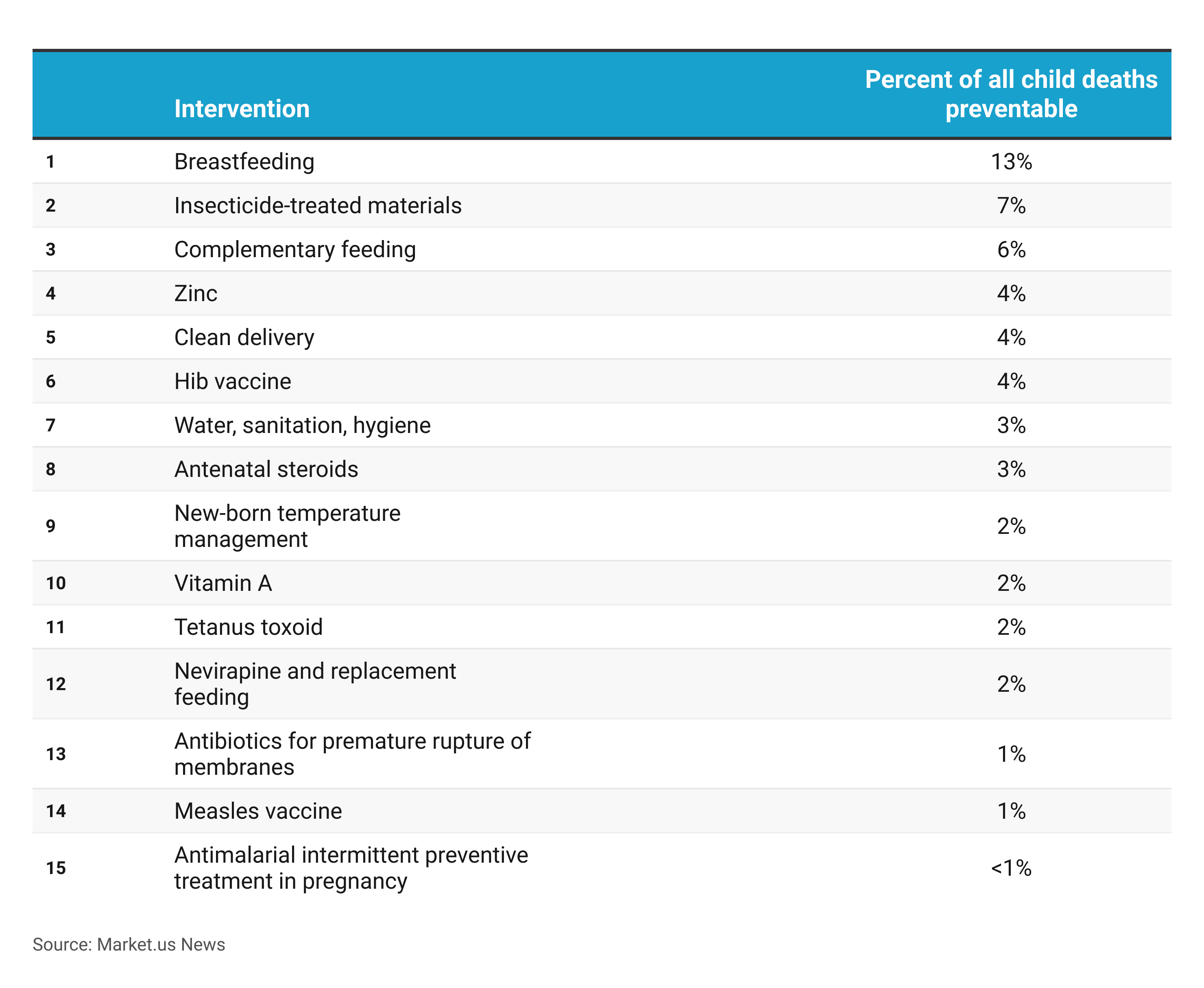
Preventive Healthcare Statistics by Country
Singapore
Singapore is widely regarded as the global leader in preventive healthcare. The country emphasizes health promotions, disease prevention, and early interventions through a comprehensive healthcare system.
- The vaccination rates for common childhood diseases such as measles, mumps, rubella (MMR), diphtheria, tetanus, pertussis (DTaP), and polio are consistently high, with coverage rates exceeding 95%.
- The participation rate in BreastScreen Singapore and CervicalScreen Singapore programs is reaching approximately 50% for breast cancer screening and 70% for cervical cancer screening.
- Singapore has implemented stringent tobacco control measures. As of 2020, the smoking rate among residents aged 18 and above was about 9.6%.
- In 2020, the Ministry of Health (MOH) funded about 5% of its non-COVID-19 related budget for preventive healthcare initiatives, amounting to USD 590 million.
- In 2021, a similar to the MOH’s non-COVID-19 related budget has been funded for preventive healthcare which amounts to USD 720 million.
(Source: Ministry of Health, Singapore)
Sweden
Sweden has a well-developed healthcare system that prioritizes preventive care. The country invests significantly in health promotions and disease prevention programs, including regular check-ups, vaccination, and lifestyle interventions.
- The vaccination coverage for children in Sweden is generally high. In 2020, the coverage rate for the 5-in-1 vaccine (diphtheria, tetanus, pertussis, polio, and Hib) was 97% for children under 5 years of age.
- In 2019, around 85% of the population aged 16 years and above reported having undergone general health examinations within the last three years.
- According to the Swedish Cancer Society, the participation rate in breast cancer screening was approximately 83% among women aged 40-74 years in 2022.
- The smoking prevalence among adults decreased from 11% in 2012 to 8% in 2020.
- Out of total health expenditure, about 3.7% of expenditure is spent on prevention and public health services.
(Source: Swedish National Board of Health and Welfare, NIH)
Norway
Norway places a strong emphasis on preventive healthcare, with a focus on early detection, regular screening, and public health comping. The country invests in promoting healthy lifestyles and provides accessible healthcare services to its population.
- The coverage rate of the primary series of vaccination in children aged 2 years and above was 95% for vaccines like diphtheria, tetanus, pertussis, polio, Haemophilus influenza type b (DTaP-IPV-Hib), and pneumococcal conjugate vaccine (PCV).
- In 2020, around 77% of women aged 50-69 participated in the national breast cancer screening program, which offers mammography screenings every two years.
- In 2019, the participation rate for cervical cancer screening in Norway was approximately 69%.
(Source: Norwegian Institute of Public Health)
Australia
- As of 2020-2021, approximately 94.7% of children aged 5 years in Australia were fully vaccinated, meeting a national immunization target.
- During the COVID-19 pandemic, over 20 million influenza doses were administrated.
- In 2019-2020, the participation rate for women in the Breast Screen Australia program was 54.8%.
- In 2021, 52.2% of eligible women participated in the National Cervical Screening program.
- Approximately 67.0% of adults aged 18 years and more were classified as overweight or obese, while 7% were daily smokers.
- In 2020, 57.7% of MBS services were for preventive health including, health assessments, immunizations, and chronic diseases.
(Source: Australian Institute of Health and Welfare)
Canada
- The national coverage rate of routine childhood immunizations at the age of 2 years was 89.8% in Canada in 2022.
- In the 2019-2020 flu season, the overall influenza vaccination coverage among Canadians aged 12 and above was 38.3%. The coverage rate was higher among seniors aged 65 and above about 0.2% as compared to younger age groups.
- The breast cancer screening rate among women aged 50 to 74 years was approximately 72%.
- The rate of colorectal cancer screening among Canadians aged 50 to 74 years was about 40.7% in 2022.
(Source: Government of Canada, Canadian Cancer Society)
Recent Developments
Acquisitions and Mergers:
- HealthTech Solutions acquired WellnessCare for $500 million, strengthening its position in the preventive healthcare market and expanding its portfolio of wellness solutions.
- PreventiveHealth merged with HealthFirst, forming a strategic partnership to offer comprehensive preventive healthcare services and integrated wellness programs, with combined annual revenues projected to exceed $1 billion.
New Product Launches:
- WellnessTech introduced a personalized health tracking app for preventive healthcare management, offering features such as activity tracking, nutritional guidance, and health risk assessments, aiming for 1 million downloads within the first year.
- PreventiveGuard launched a remote monitoring device for early detection of health issues, enabling proactive intervention and preventive care, targeting 500,000 users within six months.
Funding Rounds:
- Preventive care received $50 million in Series A funding led by Healthcare Investment Group XYZ to expand their preventive healthcare platform and invest in predictive analytics for health risk assessment, aiming for a 50% increase in user engagement within the next year.
- HealthWellness secured $30 million in seed funding from Tech Investors ABC to develop innovative preventive healthcare solutions and establish partnerships with employers and insurers, targeting a 40% growth in revenue over the next fiscal year.
Consumer Trends:
- Rising awareness of preventive healthcare fueled the adoption of digital health solutions, with a 15% increase in downloads of preventive healthcare apps compared to the previous year.
- Telehealth consultations for preventive care surged during the COVID-19 pandemic, with a 30% increase in virtual wellness visits facilitated by digital preventive healthcare platforms, reflecting the growing interest in proactive health management.
Regulatory Landscape:
- Regulatory agencies implemented guidelines for preventive healthcare services and digital health technologies, ensuring adherence to quality standards and patient privacy in preventive care delivery.
Investment in Research and Development:
- Healthcare organizations and technology companies allocated significant resources to research and development in preventive healthcare technology, with an estimated $2 billion invested globally in preventive healthcare advancements and market expansion initiatives.
Key Takeaways
Preventive Healthcare Statistics – Preventive healthcare plays a vital role in promoting overall health and well-being by focusing on disease prevention, early detection, and health promotion.
By implementing various prevention measures such as vaccinations, screenings, and lifestyle interventions, individuals and communities can significantly reduce the burden of preventable diseases and improve health outcomes.
Increasing emphasis on preventive healthcare is crucial for reducing healthcare costs, improving quality of life, and achieving better health outcomes for individuals.
By prioritizing and investing in preventive healthcare, we can work towards a healthier and more resilient future.
FAQs
Preventive healthcare also known as preventive medicine or preventive care, refers to the measures taken to prevent diseases, injuries, or other health conditions before they occur or progress. Preventive healthcare includes various aspects such as regular screening, vaccinations, lifestyle modifications, and education on healthy behaviors.
Preventive healthcare plays a crucial role in maintaining overall health and well-being. By identifying and addressing potential health risks early on, it can help prevent the onset of diseases, reduce complications, improve quality of life, and potentially save lives. It also contributes to reducing healthcare costs and burden on healthcare systems.
Examples of preventive healthcare measures include vaccinations, regular health screenings (such as blood pressure checks, mammograms, and colonoscopies), healthy diet and nutrition, physical activity, smoking cessation programs, mental health support, reproductive health services, and health education programs.


